War. War may never change, but can our perspective of it in games change? How many games do we play as a participant of combat, mowing down countless masses of faceless foes? H***, it was not long ago that the newest Call of Duty title was released. Some games do not even provide much, if any, context for your actions; using combat itself as all of the justification you need to fight this battle.
This War of Mine opts for a different approach. Rather than a combatant in the war, you play as someone caught in the crossfire between two warring sides. A civilian. A normal person. Someone like me. Hopefully though, a survivor most of all. But at what cost do we survive? Who makes the rules in a social power vacuum? This War of Mine offers a brutal and unflinching look at the effect of war on everyday people. But does it succeed? Yes, it d*** well does.
Honestly though, reviewing a game like this is a bit more difficult than some of the other games I have reviewed. Most games have several facets that can be enjoyed. Transistor was a game I greatly enjoyed, but not all players will enjoy experimenting with the functions and exploring the narrative. They can enjoy the game without being caught up in those trappings.
This War of Mine is different. The game has a sniper’s focus on one thing, and I believe it to hit the mark flawlessly. While there may be some flaws, overall the game is outstanding and something to experience. However, if anything you read past this point sounds like it does not sound right for you, you are probably right. This game is not for everyone’s enjoyment. Not only because of how singularly focused the game is, but how it confronts the players with themselves and forces the player to reflect on their actions, because they do have consequences.
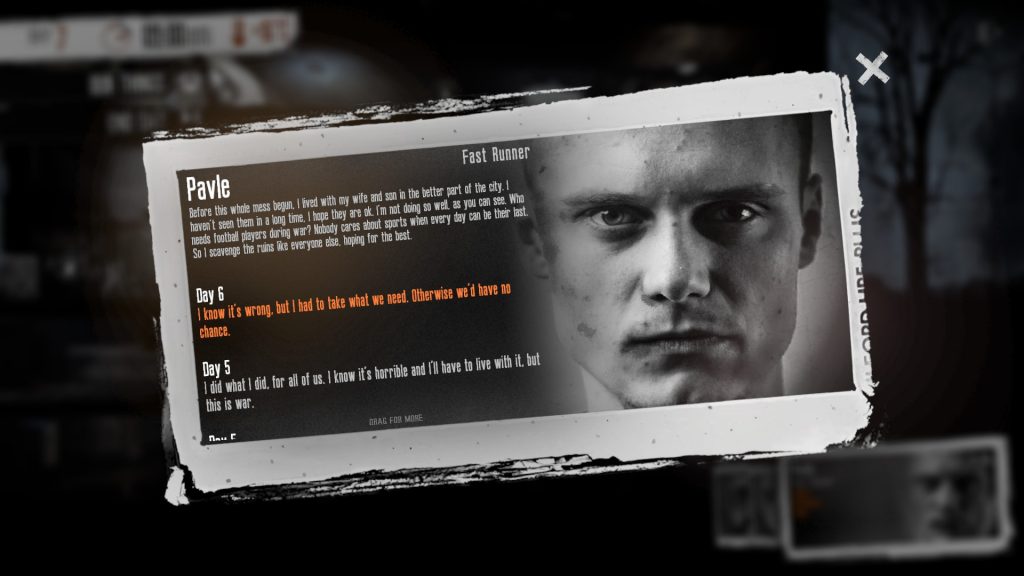
This War of Mine is a brutal game. Sure it is challenging and usually unrelenting in its difficulty, but it is brutal in a way Dark Souls can never be. This game will eat at you, constantly gnawing away at your confidence and sense of morality. One day your small and struggling band of survivors will have all of the supplies they need: food in the fridge, materials handy, weapons to defend themselves, and other necessary items. This can change in the blink of an eye.
You may be raided during the night. Your best scavenger may be shot by a bandit or a fellow survivor, simply because you ventured too close to their stash. You can prepare all you like, but like life, there will always be a shot out of left field to keep you on edge. A situation that was completely unplanned for and now you are struggling to simply stay alive. It is in moments like this where the game shines.
The game is also unflinching in dealing with the human element and impact of war. Your group’s morale is especially important and what one person does, affects the entire group. If you do not maintain your group’s morale, characters may even commit suicide rather than live with the actions they have done or done by their comrades. The game pulls no punches with its bleak portrayal of the impact of war upon everyday people.
The game has some “rogue-lite” elements. However, there are constants. You always start with three survivors and a small pool of resources. Your job is then to ensure they survive, by whatever means you are comfortable with doing. The game has randomness regarding the locations you can visit.
The main gameplay is separated into two distinct phases: day and night. During the day, you guide your refugees around their shelter, crafting items, interacting with one another, and whatever else needs to be done. The night is when you can send one of your group out into the unknown in an attempt to gather supplies. The order in which you can visit these locations is randomized as is the hazards with each location.

During one play through, a certain house was inhabited only by the wildlife of the fictional city. The next play through found the house crawling with vicious bandits. Like many games with “rogue-lite” elements, it is also common to simply find yourself in a bad starting point from which you cannot recover. Needless to say, it can be frustrating to invest one hour or more into a play through, only to be sabotaged by terrible luck. However, given the context of the game, it does make perfect sense as to why you will not always have what you need or be able to easily find it.
This War of Mine faces you with difficult choices while never explicitly alerting the player to said choice. While Spec Ops: The Line has explored the murkiness of morality in war, the major moral dilemmas were signposted and the player was forced into a crossroad of choices. The player was not openly aware of all of the choices in that game, but when it came time to make a major choice, the player knew. This War of Mine is not punctuated with major, diverging choices which the player is aware of, but rather several smaller choices throughout the experience that add to a cohesive whole. The main question is how far will you go to ensure your group survives? Will you rob from fellow survivors, especially the elderly and defenseless? Will you kill in cold blood? Will you only retaliate when provoked, even if that means some of the group may be in lethal danger and die? Will you risk helping your neighbors?
Choices like these are what contribute to the moral core of the game and provide the backbone for player agency. Once you have made some progress in a playthrough, the consequences of your actions will start to slowly rear their ugly heads and be made clear. Unlike some games with moral decisions, your choices here actually tie into the mechanics of the game. Members of your group who are depressed are likely to resist tasks assigned to them, try to sleep more, avoid others, and possibly even attempt suicide. You as the player feel the draining effects of the situation on your characters.
Another noteworthy feat is how 11-Bit Studios handled the backstory and personalities of each character in your group. In the bottom right are cards of your group. Each card has the name of the refugee, their status and ailments (sick, wounded, tired, etc) and their defining trait. One member might be skilled in combat and another might be a fast runner compared to the others. From the card of each character, you can access the character’s bio. Here you can find what may cheer them up, bits of their backstory as you progress, and their reactions to your choices and their actions. While these stories are a tad barebones, they allow the player to fill in the blanks and decide who these people are and what you will make them do.
This is also the source of one of major issues with the game, character dissonance. In my time, the character Bruno always seemed like the “survival for us at all costs, forget everyone else” guy. At least, according to his card this was his personality. In the game however, several times Bruno would lament about the people who had died last night, only to seem distanced and uncaring on his character card. While it does not break the game or lessen the emotional impact, it was still something that prevented me from connecting with some characters.
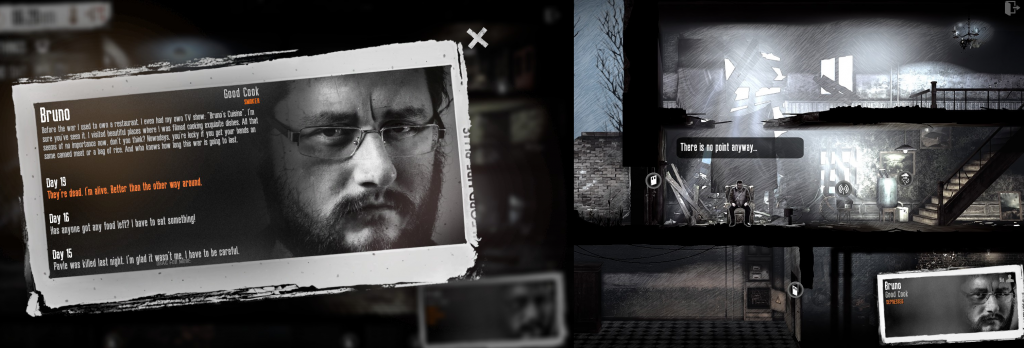
Some will not be a fan of the repetitious nature of the game. Having “rogue-lite” elements, the repetitive nature is understandable. The gameplay unfolds in a two dimensional perspective and you control characters similar to a point and click adventure game. Actions or objects you can interact with will have an icon over them, so you are always aware of what exactly you can interact with in some capacity. Most of the gameplay consists of scavenging for supplies at night and building necessary items for survival in the day.
As I mentioned, the majority of your playtime and interaction with the game comes via making your choices and the consequences of said actions. While normally a repetitive nature would be a detractor, in some cases at least, I do not believe that is the case with This War of Mine. The reason being this is not a game that is meant to be played for hours on end, in my opinion. I played through two playthroughs back to back, and it was one of the most draining experiences I have ever played. Like Spec Ops: The Line before it, this game is engaging, but certainly not fun. However, being engaging without being fun is far from a detractor. It is quite the opposite; it is one of the game’s greatest strengths. To engulf a player completely and have them transfixed by the events occurring onscreen without the player having fun is a remarkable achievement few games have been able to do.
This War of Mine has an oppressive mood, applicable given the setting. While the setting is certainly grim, the art aesthetic goes a long way towards enhancing the mood. As I mentioned, the game’s perspective is 2-D. Characters and the objects you can interact with and the things you craft are rendered in 3-D. The entire world has a pencil, sketched look in the background. The sketched lines themselves are dynamic, much like the darkness in Neverending Nightmares. This art choice helps further the oppressive mood and ensures the game stands out from the crowd with a unique art aesthetic. The game looks fantastic in motion with the dynamic lines in the background. I cannot stress enough how much this dynamic art affects the game and how terrific it looks as a result. Screens really do not do the game justice. The music is mostly ambient, except for some tense situations where the music really becomes noticeable.
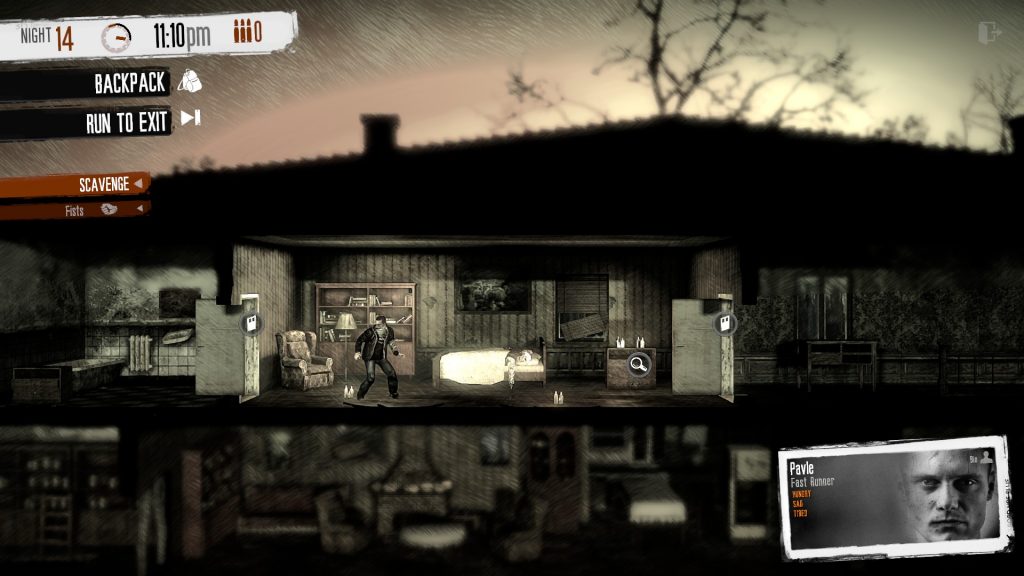
What does your purchase net you?
The game is currently retailing for $19.99. Depending on your luck and decisions, your attempts at survival can last from one hour to quite a bit. The ending of each run, the end of the war, is different every time. One run may only take thirty days while another trip into H*** may last over fifty. Your replayability factor largely depends on how much of the game’s emotional weight you can bear as the player. This is a game you play from time to time and reflect on your choices in the quietness of your room; this is not a game you play every day, or for hours and hours on end.
The Bottom Line
This War of Mine is a different approach to war in games, and it succeeds at what 11-Bit intended for the game to do. The game drives home the human element of war and the consequences of war on the everyday person. This has been a difficult review to write because I believe this is a game people should play and experience, but it is NOT for everyone. However, if anything I have said intrigues you in any way, I highly recommend checking out this title.
Just be ready for what comes with the game.
Moment of Artistry
One of your characters is depressed and despite all your best efforts, you cannot raise their spirits. And as the player you realize it is starting to wear on you and dampen your spirits.
Pros
+ Moody and bleak atmosphere
+ Thought-provoking and meaningful
+ Realistic approach to war
+ Player choice integrated with actual mechanics
+ Dealing with the consequences of said choices
+ Fantastic art style
+ Engaging
+ Link to the War Child charity on the title screen
Cons
– Some moments of character dissonance
– Not a game for everyone
– Depictions of depression may hit too close to home
Unique/Reservations
Curious as to what those letters mean? Click here for our review system.
This review was conducted with a copy of the game provided by the developer.
This War of Mine can be purchased on Steam, GOG.com, and the Humble Store.







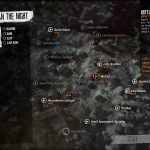


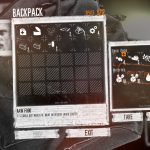














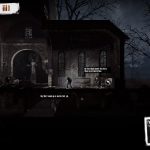




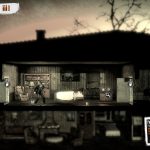


 …WOOLY DESERVES BETTER LOL!
…WOOLY DESERVES BETTER LOL!